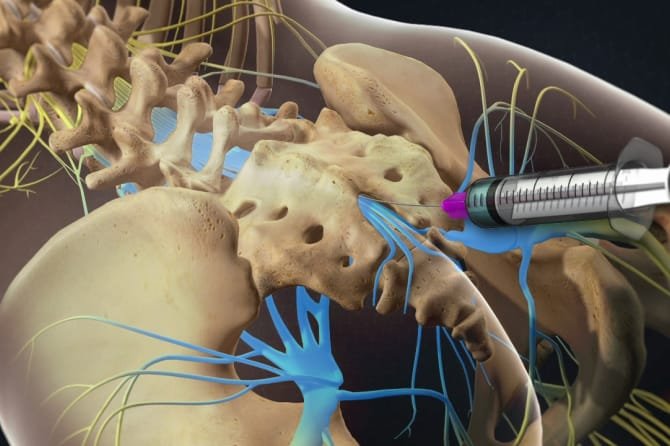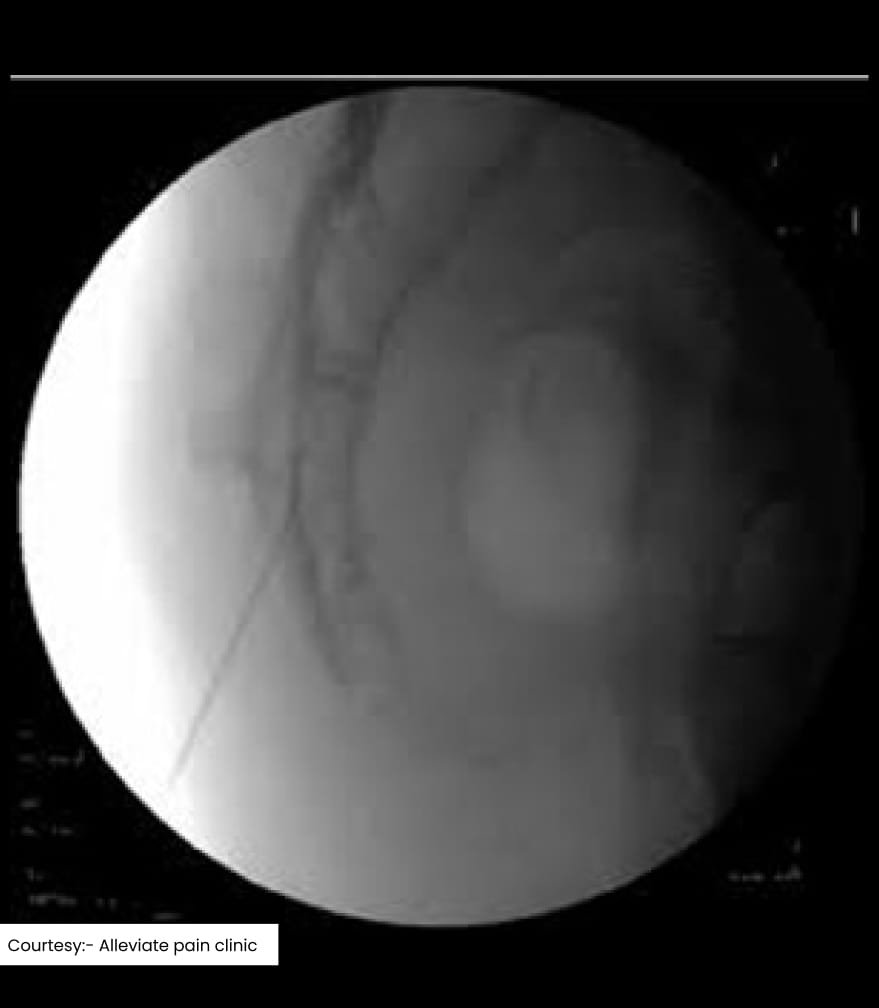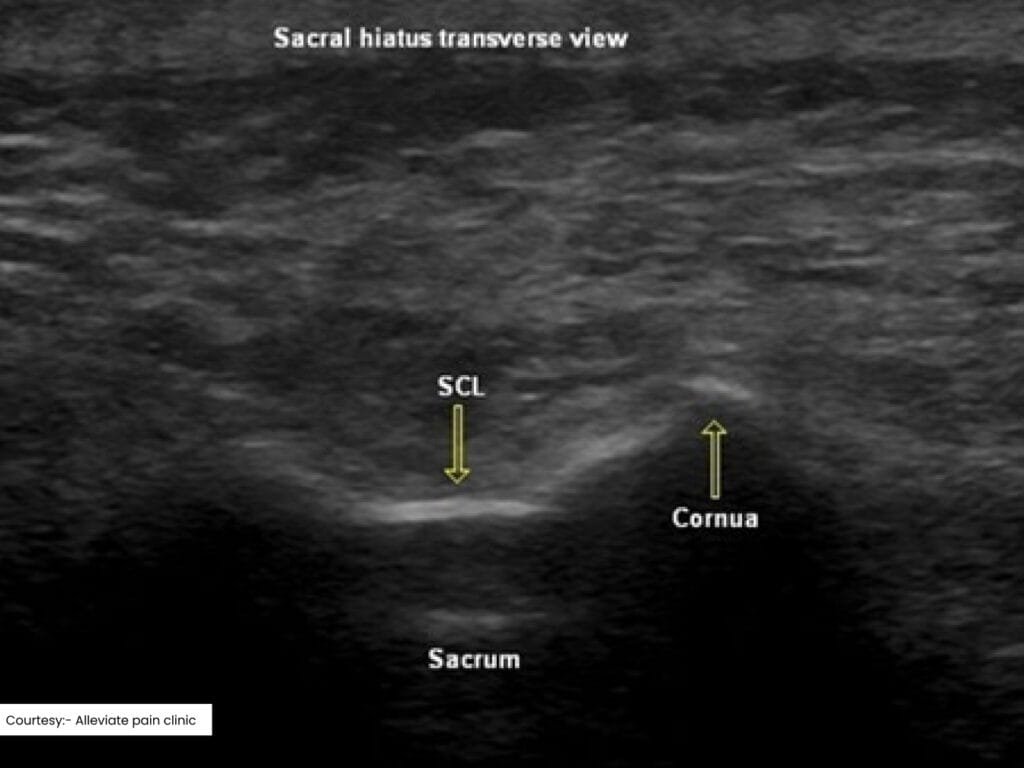
At Alleviate Pain Clinic, we specialize in a range of interventional pain management techniques aimed at providing long-lasting relief from chronic pain. One such effective treatment is the caudal epidural injection, a minimally invasive procedure designed to target pain in the lower back, legs, and tailbone area. In this blog, we’ll explore the indications, precautions, procedure details, and what you can expect from this treatment.
What is a Caudal Epidural Injection?
A caudal epidural injection involves delivering a mixture of anti-inflammatory steroids and local anesthetic into the epidural space at the base of the spine (the sacral hiatus). This treatment reduces inflammation and blocks pain signals, offering relief from a range of conditions affecting the lower back and legs.

Fluoroscopy guided caudal epidural injection
Indications for Caudal Epidural Injection
Caudal epidural injections are typically recommended for patients experiencing pain due to
- Lumbar disc herniation: Discs in the lower spine press against nerve roots, causing pain.
- Sciatica: Nerve compression leads to shooting pain down the legs.
- Spinal stenosis: Narrowing of the spinal canal causes pain in the lower back and legs.
- Degenerative disc disease: Wear and tear on spinal discs can lead to chronic pain.
- Radiculopathy: Irritation of nerve roots from various causes, resulting in radiating pain.
This procedure is especially effective for patients who haven’t responded to conservative treatments like physical therapy, medications, or rest.
Precautions Before a Caudal Epidural Injection
At Alleviate Pain Clinic, patient safety is our priority. We take the following precautions before performing the procedure:
- Medical history review: We thoroughly review your medical history, including any allergies, medications, or prior surgeries.
- Blood thinners: If you’re on anticoagulants or blood thinners, we may advise pausing these medications to reduce the risk of bleeding.
- Infection risk: Any active infection will delay the procedure until it has been resolved.
- Pregnancy: While generally safe, we carefully assess the risk before proceeding with the injection during pregnancy.
Procedure: What Does a Caudal Epidural Injection Involve?
Preparation
Before the procedure, you’ll be asked to lie face down on a treatment table. The injection site near the tailbone is cleansed, and a local anesthetic is applied to minimize discomfort.
Injection Mixture
The injection contains a mixture of:
- Corticosteroids: To reduce inflammation and swelling in the affected area.
- Local anesthetic: To numb the area and provide immediate pain relief.
Image Guidance
To ensure precision and safety, the injection is administered under image guidance, which may be:
- Fluoroscopy (X-ray): Provides real-time imaging and is the most commonly used guidance method. A contrast dye is injected to confirm the correct placement of the needle.
- Ultrasound: Offers real-time visualization of soft tissues and nerves without radiation exposure. It’s a viable option for patients for whom minimizing radiation is a priority.

Ultrasound guided caudal epidural injection
Technique
Sterilization and Anesthesia: The area is cleaned with an antiseptic solution, and a local anesthetic is applied to numb the skin and surrounding tissue.
Needle Insertion: A needle is carefully inserted into the caudal epidural space using fluoroscopic or ultrasound guidance.
Injection: Once the correct position is confirmed, the steroid-anesthetic mixture is slowly injected into the epidural space. The entire process takes around 15 to 30 minutes.
What to Expect After the Procedure
After the caudal epidural injection, most patients experience significant pain relief within a few days. Some may feel immediate relief due to the local anesthetic, while others may notice improvement as the corticosteroid reduces inflammation over the following week.
Post-Procedure Care
Rest: Take it easy for the first 24 hours, avoiding strenuous activities.
Pain relief: You may experience mild soreness at the injection site, which should resolve within a few days.
Follow-up: We’ll schedule a follow-up appointment to assess your response and determine if additional treatments are needed.
Why Choose Alleviate Pain Clinic?
At Alleviate Pain Clinic, we’re dedicated to providing patient-centered care with the latest advancements in pain management. Our team of specialists is experienced in performing caudal epidural injections using both fluoroscopy and ultrasound, ensuring precise delivery and optimal outcomes.
If you’re suffering from chronic lower back or leg pain, don’t let it control your life. Contact us at Alleviate Pain Clinic to discuss whether a caudal epidural injection is right for you. Our team is ready to help you get back to living pain-free!





